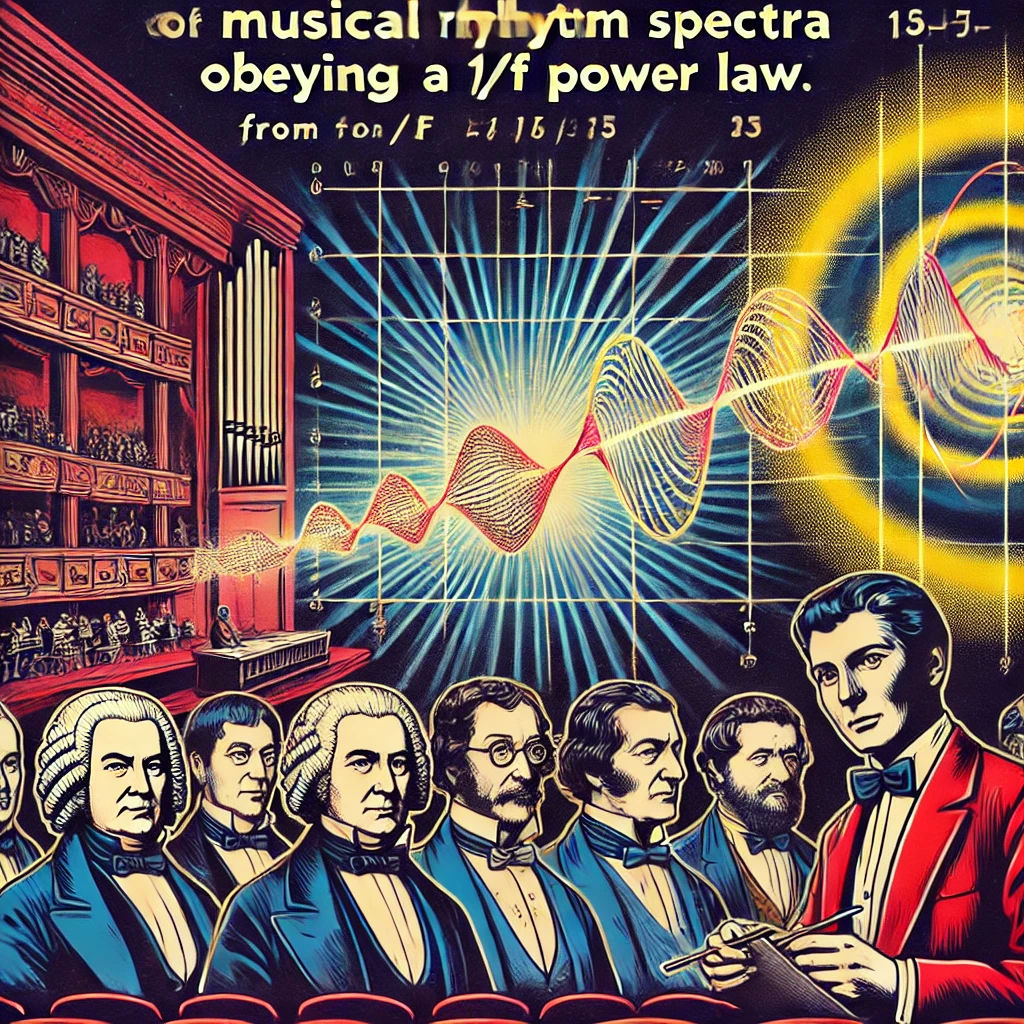Musical rhythm spectra from Bach to Joplin obey a 1 over F power law
Much of our enjoyment of music comes from its balance of predictability and surprise. Musical pitch fluctuations follow a 1/f power law that precisely achieves this balance. Musical rhythms, especially those of Western classical music, are considered highly regular and predictable, and this predictability has been hypothesized to underlie rhythm’s contribution to our enjoyment of music.
Are musical rhythms indeed entirely predictable and how do they vary with genre and composer? To answer this question, we analyzed the rhythm spectra of 1,788 movements from 558 compositions of Western classical music. We found that an overwhelming majority of rhythms obeyed a 1/f β power law across 16 subgenres and 40 composers, with β ranging from 1.5-1. Notably, classical composers, whose compositions are known to exhibit nearly identical 1/f pitch spectra, demonstrated distinctive 1/f rhythm spectra: Beethoven’s rhythms were among the most predictable, and Mozart’s among the least. Our finding of the ubiquity of 1/f rhythm spectra in compositions spanning nearly four centuries demonstrates that, as with musical pitch, musical rhythms also exhibit a balance of predictability and surprise that could contribute in a fundamental way to our aesthetic experience of music.
Although music compositions are intended to be performed, the fact that the notated rhythms follow a 1/f spectrum indicates that such structure is no mere artifact of performance or perception, but rather, exists within the written composition before the music is performed. Furthermore, composers systematically manipulate (consciously or otherwise) the predictability in 1/f rhythms to give their compositions unique identities.
http://www.pnas.org/content/109/10/3716.full.pdf+html
A 1/f power law, also known as “pink noise” or “flicker noise,” describes a mathematical relationship where the power of a signal decreases in proportion to its frequency raised to the power of -1. In the context of music, this would imply that lower frequencies (longer rhythmic patterns or cycles) have more power or energy compared to higher frequencies (shorter rhythmic patterns or cycles).
If musical rhythm spectra indeed follow a 1/f power law from Bach to Joplin, it suggests that there is a fundamental similarity in the rhythmic structure of compositions across different genres and time periods. This would imply that there are underlying principles or constraints that govern the organization of rhythm in music, regardless of stylistic differences.
The observation that musical rhythm spectra from composers like Bach to Joplin obey a 1/f power law refers to an intriguing pattern found in the analysis of musical compositions across different periods and styles. The 1/f noise, also known as pink noise or flicker noise, is a signal or process with a frequency spectrum that falls off steadily with frequency. In music, this translates to a balance between predictability and surprise, providing a pleasing and engaging listening experience.
Understanding 1/f Noise
1/f noise is characterized by its power spectral density (PSD), where the power decreases inversely with the frequency. This means that lower frequencies have more power than higher frequencies, but the distribution is more balanced than in white noise (where power is constant across frequencies) or brown noise (where power decreases more rapidly with frequency).
Application to Musical Rhythms
The claim that musical rhythm spectra from composers ranging from Bach to Joplin follow a 1/f power law suggests that these compositions naturally incorporate a mix of predictability and novelty that resonates with listeners. This pattern has been found not just in classical music but across a wide range of genres, indicating a universal aesthetic preference or perceptual bias in human music appreciation.
Implications for Music Composition and Perception
– Composition: The adherence to a 1/f rhythm pattern might be a factor in the lasting popularity and aesthetic appeal of certain musical works. Composers, perhaps intuitively, create compositions that balance repetition and variation in a way that aligns with the 1/f distribution, catering to human perceptual preferences.
– Perception: The preference for 1/f noise in music suggests that our brains are wired to appreciate a certain level of complexity in auditory stimuli. Music that is too predictable (white noise) or too unpredictable (brown noise) might not engage listeners as effectively as music that strikes a balance (pink noise).
– Music Analysis: This observation provides a quantitative tool for analyzing music and understanding its impact on listeners. By examining how closely different pieces or genres conform to the 1/f pattern, researchers can gain insights into their potential appeal and staying power.
Conclusion
The observation that musical rhythm spectra from Bach to Joplin obey a 1/f power law highlights an intriguing intersection between music theory, psychology, and mathematical patterns. This phenomenon underscores the complexity of musical appreciation and suggests that certain universal principles may underpin our enjoyment of music. Understanding these principles not only enriches our appreciation of music but also offers insights into human cognition and the nature of artistic expression.
